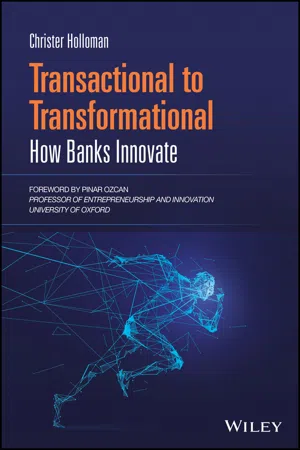
- English
- ePUB (mobile friendly)
- Available on iOS & Android
About This Book
Through a series of case studies you are invited to meet, and learn firsthand from, the people and teams that have delivered a number of very different innovations successfully across a diverse group of banks; big and small, long established and brand new, from the east and west!
Banks featured include: Bank of America, BBVA, Citi, Crédit Agricole, Danske Bank, Deutsche Bank, ING, J.P. Morgan, Lloyds Bank, Metro Bank, N26, National Australia Bank, Royal Bank of Canada, Santander, Standard Chartered and Swedbank.
This book will equip you with ideas, tools and actionable hands-on advice. You will discover the untold stories about how these banks delivered new solutions to consumers and businesses, products as well as services, across the spectrum of buy, build and partner.
Here are some of the innovation challenges you can overcome by learning from those that already did:
- Working around legacy systems
- Limited tech resources and budget
- Secure budget and buy-in from the exec team
- Creating a culture that embrace innovation
- Compete with fintechs and big tech for new talent
- Validating actual customer demand
- Increasing speed to market whilst satisfying risk and compliance
- Retain control when partnering with third parties
- Making the right priorities
- When to shut something down
Once you have bought this book you can register on www.howbanksinnovate.com to access more in-depth material from all of the banks featured, full-length interviews and videos.
Frequently asked questions
Information
Part I
Buy
Chapter 1
Lloyds Banking Group: Investing from the Balance Sheet
Case: Thought Machine

Executive Summary
Introductions
www.howbanksinnovate.com.
Juan Gomez Reino, Group Chief Technology Officer

Carla Antunes da Silva, Group Strategy Director

Zak Mian, Group Transformation Director
Background
Key Figures
- Total assets: £900 billion
- Number of customers: 30 million
- Number of branches: 2,000
- Number of employees: 60,000
- (Approximate as of 2020)
- Leading customer experience. In order to be the best bank for customers, they recognise that they must continue to adapt to changes in customer behaviour, technology‐driven competition and regulation. Their propositions must be reflective of heightened customer expectations for ease of access, personalisation and relevance, as well as the needs created by changing life patterns. In September 2020, their digital bank had 17.1 million active users.
- Digitising the group. Their cost position and customer franchise are sources of competitive advantage. However, they are not complacent and realise they must further digitise the group to drive additional operational efficiencies, improve the experience of their customers and colleagues and allow them to invest more for the future. In addition, they must continue to simplify and progressively transform their IT architecture in order to use data more efficiently, enhance their multichannel customer engagement and create a scalable and resilient infrastructure.
- Maximising the group's capabilities. To better address their customers' banking and insurance needs as an integrated financial services provider and improve their overall experience, they want to make better use of their competitive strengths and unique business model.
- Transforming their ways of working. Their colleagues are crucial to the success of their business. In order to deliver their transformation during the current strategic plan and beyond, their colleagues will require new skills and capabilities to reflect the changing needs of the business as it adapts to the evolving operating environment. At the same time, colleague expectations of their employers are changing. As a result, they are making their biggest ever investment in colleagues to ensure that they continue to attract, develop and retain these skills and capabilities, while fostering a culture that supports a way of working that is agile, trust‐based and reinforces the group's values.
Problem
Table of contents
- Cover
- Table of Contents
- Title Page
- Copyright
- Dedication
- Foreword
- Introduction
- Part I: Buy
- Part II: Build
- Part III: Partner
- Part IV: Bonus: Ways of Working
- Index
- End User License Agreement